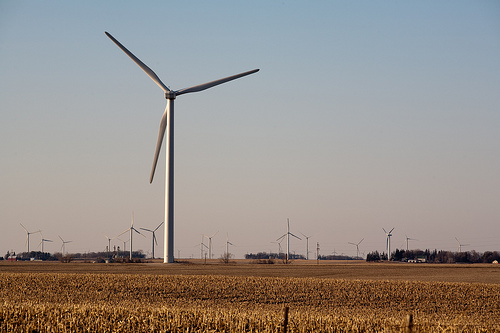Something extraordinary happened in Iowa earlier this month. Almost nobody noticed.
On March 7, the Iowa Senate Agriculture Committee passed a bill that would encourage ownership of small-scale wind power by the state’s farmers. What’s extraordinary is that the bill passed unanimously, supported by the committee’s eight Democrats and five Republicans, backed by both the Iowa Farmers Union and the Iowa Environmental Council.
In other words, what we’ve got here is a bona fide example of bipartisan clean-energy policy. And you thought there was no such thing!
As far as I can tell, the only stories that have been written on this are one by wind analyst Paul Gipe and another by the (low-key but consistently excellent) Midwest Energy News.
But … it’s Democrats and Republicans working together to support distributed clean energy! That is a milestone and, I hope, a sign of things to come. Let’s take a moment to celebrate.

OK, enough of that. Now I’ll explain all the caveats and qualifications and reasons not to get too excited yet.
The bill is quite specific: It is a feed-in tariff for wind power installations of 20 megawatts or less on agricultural land. “Feed-in tariff” (FIT) means that utilities are required to contract with those who install wind turbines on their land to pay a fair price for the power they produce, as determined by the Iowa Utility Board, for 10 years. (There are all kinds of technical legal questions here about who has the authority to set rates, but I’ll do you a favor and skip over them.)
Feed-in tariffs are popular in other countries, most notably Germany, and they’re responsible for most large-scale adoption of distributed energy. But only a handful of U.S. states and cities have passed them, and those FITs have been fairly modest.
For now, the Iowa bill only applies to agricultural land, and only to wind (which is unusual for feed-in tariffs, which tend to be solar-focused). And it caps the growth of distributed wind at half the utility’s sales growth the previous year. As it stands, that would mean about 60 MW of distributed wind power capacity a year — not a huge deal in the grand scheme of things (Iowa already has 5,137 MW of wind capacity installed), but pretty beefy relative to other U.S. FITs.
Why is this so cool, other than the bipartisan aspect? It would start to shift some of the benefits of Iowa’s wind boom into the hands of the state’s citizens. Iowa’s wind industry is growing quickly. The state is third in the nation in wind capacity, behind Texas and California. In 2012, it produced more wind power than California — almost 25 percent of its total electricity use.
But right now virtually all of that wind power comes from big farms owned by multinationals. Contrast that to Germany, where over half the country’s renewable energy is locally owned. With local ownership, more of the economic benefits of wind stay within Iowa. Just as importantly, with local ownership, more Iowans have direct experience with, and a stake in, clean energy. As I’ve said before, encouraging distributed energy creates political constituencies. And in Iowa that constituency now crosses party lines.
Or at least it kinda does. The bill still faces an extremely steep path to becoming law. First it must go before the full Senate, which is controlled by Democrats. (There, the bill’s backers say they may add solar and biomass to the qualifying technologies.) Assuming it passes, it must also pass through the House, which is controlled by Republicans, and be signed by the governor, who is a Republican.
Most dauntingly, the bill has yet to face the full brunt of opposition. It kind of snuck through the committee at the last minute and took the industry by surprise. But have no doubt: Fossil fuel companies and big utilities will throw a ton of money and lobbying at this thing, trying to kill it. And they have a ton of money to throw. The bill’s backers, bless their hearts, seem well-meaning but not particularly media savvy and in no way prepared to cope with the onslaught. The bill could very well be strangled by industry money before it gets any farther. (Hey, national green groups and climate campaigners — maybe you should get involved!)
Nonetheless, I think this is an early glimpse of things to come. Cynics and libertarians will say, “Yeah, of course it’s bipartisan, it’s farmers angling for a subsidy. What could be more bipartisan in the Midwest?” And, well, yeah. That’s kind of the point. In the real world, legislation is rarely passed on the basis of the public good alone. Bills pass when they are backed by powerful constituencies. Now, in Iowa, a state smack in the middle of the American Heartland, wind energy has powerful constituencies backing it! That’s a big deal. Other constituencies will see farmers reaping the benefits of local energy and they’ll want a piece of the action. Soon local ownership of clean energy will come to seem the right and privilege of everyone living in the state. Iowan voters will have a personal stake in seeing clean-energy industries continue to grow. Hallelujah!
As I’ve said for years, bipartisan, pragmatic action on clean energy will emerge first in states where clean industries become large and politically powerful. That’s finally beginning to happen, though it’s still early in the game. And it’s happening in purple and red states, pushing a wedge between state and federal Republicans. A savvy movement would exploit that wedge.
Here’s hoping this is only the first of many similar stories.



